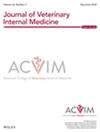Antibiograms of Bacterial Cultures From Equine Neonates at a United Kingdom Hospital: 381 Samples (2018–2023)
Abstract
Background
Geographical specific data is required to guide empirical antimicrobial selection in equine neonates.
Objectives
Evaluate antibiograms and survival in foals from a United Kingdom (UK)-based hospital to guide antimicrobial selection.
Animals
Blood and synovial fluid samples from 208 foals ≤ 30 days old admitted to Rossdales Equine Hospital from 2018 to 2023.
Methods
Retrospective cohort study. Antimicrobial susceptibility was assessed by disc diffusion method. Bacterial culture and susceptibility and foal survival were recorded. The effects of the presence of positive culture or multidrug resistance (MDR) isolates on survival were evaluated using univariable mixed effects logistic regression.
Results
Ninety-one isolates were identified from 381 samples from 208 foals. Predominantly gram-positive (75%, 68/91; 95% confidence interval [CI]: 65%–83%) isolates were identified, and Enterococcus (26%, 24/91; 95% CI: 18%–37%) was the most commonly isolated bacteria. MDR was identified in 21% of isolates (19/91; 95% CI: 13%–31%). Enterococcus was the most frequent MDR isolate (7/19). The combination of ampicillin and amikacin showed in vitro susceptibility in 90% (81/90; 95% CI: 82%–95%) of aerobic isolates. In total, 87% of foals were discharged from the hospital (180/208; 95% CI: 81%–91%). No association was identified between survival and the presence of positive culture or MDR isolates.
Main Limitations
Retrospective design; missing data for prior antimicrobial treatment, reason for admission and admission variables.
Conclusions and Clinical Importance
Ampicillin and amikacin are appropriate combination first-line antimicrobial treatments in this population. Many Gram-positive isolates were identified, most notably Enterococcus. Culture and susceptibility guided antimicrobial choices remain crucial, especially given the unpredictable susceptibility of Enterococcus and the frequency of MDR Enterococcus isolates identified.


 求助内容:
求助内容: 应助结果提醒方式:
应助结果提醒方式:


